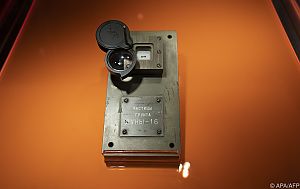Researchers found billion-year-old micrometeorite in lunar sample

The Moon is littered with impact craters, but there are hardly any traces of meteorites in the samples brought to Earth by the Apollo and Luna missions. A team of researchers with Austrian participation has now identified a meteorite fragment in a soil sample collected by Luna-16, which probably struck about a billion years ago, it reports in the journal Nature Astronomy.
On the Earth-facing side of the moon alone, there are about 300,000 craters with a diameter of more than one kilometre. However, in the approximately 380 kilograms of lunar rocks and dust brought back to Earth by the US Apollo and Russian Luna missions in the 1960s and 1970s, only tiny iron-nickel metal grains of presumably meteoritic origin have been found so far.
"Only two meteorite fragments have been clearly identified in the samples so far," Franz Brandstätter, former director of the Mineralogical-Petrographical Department of the Natural History Museum (NHM) Vienna, told APA. He has continued to work as an associate scientist at the museum since his retirement and was involved in the investigation of the fragment.
One reason for the almost non-existent meteorite traces is the moon's lack of atmosphere. "Even tiny pieces hit there unchecked, and due to the constant bombardment, parts of the several-metre-thick layer of regolith that covers large areas of the moon's surface have been repeatedly melted, vaporised and mixed over billions of years," says Brandstätter.
Microanalysis enables new research
But advances in microanalysis would justify a renewed and systematic search for remnants of meteorites in lunar soil samples. Because it is now possible to determine the properties of even micrometre-sized pieces in detail, the researchers write in the paper.
Launched on 12 September 1970, the "Luna 16" probe was the first Soviet mission to bring lunar rocks back to Earth. It was from these samples that the piece measuring around 200 micrometres, which the scientists led by Svetlana Demidova of the Russian Academy of Sciences, have now identified in the current paper as a fragment of a meteorite and have been able to assign to a specific type of meteorite. "It is a piece with typical features of LL chondrites, one of the most common meteorite groups," said Brandstätter, who worked on the mineralogical characterisation of the fragment together with Theodoros Ntaflos from the University of Vienna.
"It showed that this fragment has a quite remarkable match with particles collected from the asteroid 'Itokawa'," Brandstätter said. The Japanese probe Hayabusa had taken samples from an asteroid for the first time in the history of space travel in 2005 and brought them back to Earth in 2010.
Falling age around one billion years
A distinction is made between the age at which a meteorite is formed and the age at which it falls. The latter corresponds to the time that has elapsed since the impact of a meteorite. Within the framework of the study, the scientists were also able to roughly determine the fall age of the micrometeorite. They estimate that this is at least around one billion years.
"All meteorites found on Earth have a much younger fall age, perhaps a few million years at most," says Brandstätter. The reason for this is weathering and geological processes that continue to this day, through which no two stones remain the same. Both are largely absent on the moon.
Using the mineral merrillite, the scientists were able to determine the age of origin of the meteorite fragment at around 4.5 billion years. "This corresponds to the early stages of the development of our solar system and is consistent with the time when the components of the chrondrites were formed," Brandstätter said. (APA)
